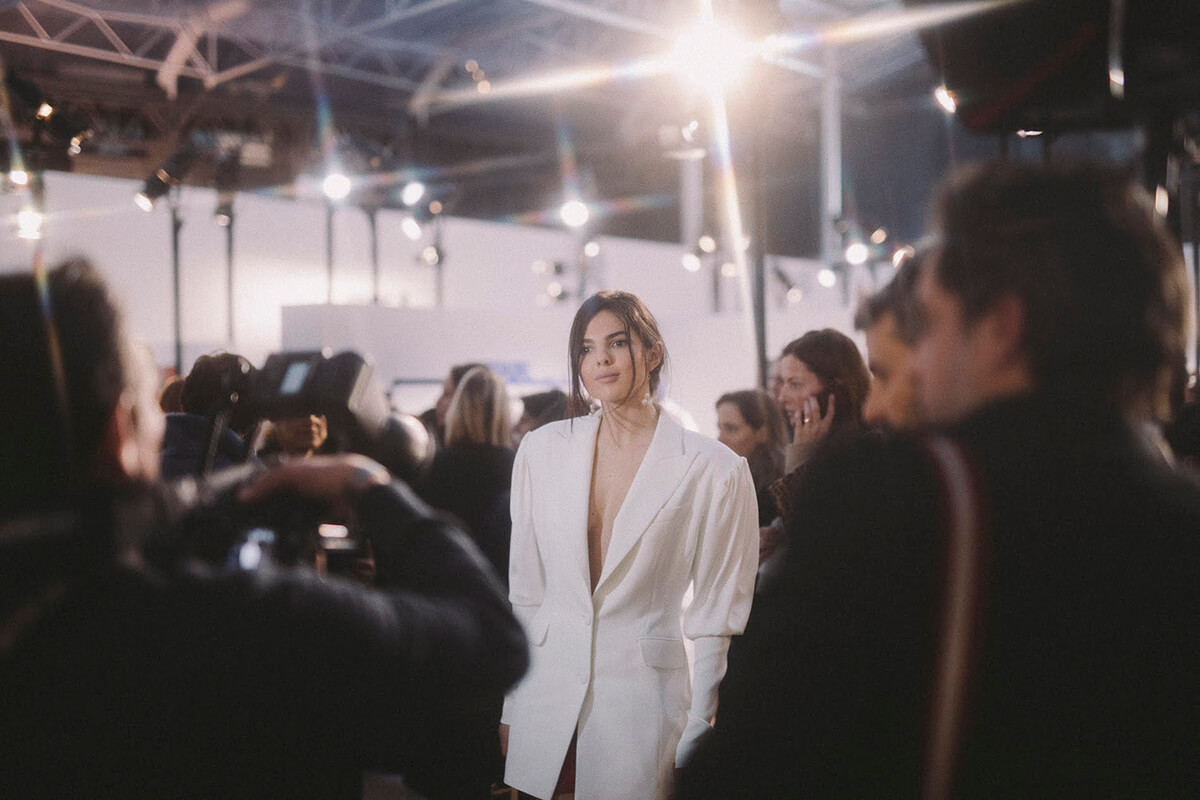
LVMH’s Delphine Arnault with Karl Lagerfeld at the LVMH Prize 2018 cocktail reception ©François GOIZE
The LVMH prize is the most prestigious and desirable award for any emerging designer. Lauren Cochrane reports from Paris on the mix of established and new and the ideas bubbling around a competition aimed at discovering the next John Galliano or Alexander McQueen
This spring, as Paris Fashion Week swirled around them, some of the industry’s highest profile names – JW Anderson, Nicolas Ghesquière, Maria Grazia Chiuri, Bella Hadid, Suzy Menkes and Karl Lagerfeld included – found a moment in their busy diaries. The reason? The shortlisting of the LVMH Prize. Over two days, with LVMH’s Delphine Arnault, fashion’s brightest and best whittled a shortlist of 20 semi-finalists down to just nine. After an additional round of judging, the final winner is announced in June.
Follow LUX on Instagram: the.official.lux.magazine
In the four short years since its launch, the LVMH Prize has become the most prestigious in fashion. Each winner is given a grant of 300,000 euros and access to mentoring from LVMH experts to develop their business. Winners so far have included minimalist Thomas Tait and Grace Wales Bonner, the visionary of London’s menswear scene. Simon Porte Jacquemus, a designer mooted for the top job at Lanvin, was a special prize winner in 2015. Marine Serre, 2017’s winner, has already caused a stir. After her debut show in March, the New York Times said she had come “far, fast”, while Vogue called her collection “terrific”.

Designer Snow Xue Gao with model ©François GOIZE
Of course, fashion insiders will take note of anything that comes with the LVMH name attached. With Bernard Arnault at the head, it is the biggest luxury group in the world, taking in a record 42.6 billion euros in 2017 across brands including Louis Vuitton, Christian Dior and Givenchy. The impact of LVMH’s endorsement and mentoring (not to mention that cash injection) on a young designer’s career cannot be underestimated. Serre, speaking to Vogue, said what the win meant: “It was possible for us to really take things to a whole new level”, allowing her to hire new staff and expand into a new studio space. Marta Marques and Paulo Almeida echo this. “We suddenly had the exposure, the support and the funding to put into existence a lot of the things we always wanted to do, and grow the company,” they said in an email. “This is what the foundations of our label is built on and what the company is today.” Winning the LVMH Prize can turn a fledgling operation into a bona fide brand.
Read more: We ask artist Mouna Rebeiz about trash and beauty
Jean-Paul Claverie, advisor to Bernard Arnault, was instrumental in setting up the Prize in 2014 and he sits on the jury. The Director of Corporate Sponsorship at LVMH, he describes the prize as a way for “young designers to value creativity first”. LVMH are committed to that pledge. Designers are only eligible if they have shown two collections or fewer, and there is an in-house team that works specifically on the prize, selecting the final 20 designers who go before the jury. Relationships continue beyond the competition process, too. “We stay in touch with many of the winners and we are ready to help if they have a problem,” says Claverie. “The door is always open.”

Menswear designer Charles Jeffrey ©François GOIZE
Each year the number of applications has grown, with 1,300 in 2018, including designers from South Korea, China and countries in Africa. Among the 20 semi-finalists there was A Cold Wall, the London-based label by Samuel Ross, New York’s Eckhaus Latta, who put a pregnant woman on their catwalk in September, Charles Jeffrey’s artistic take on menswear and five gender-neutral labels including Faustine Steinmetz, GMBH and The Sirius. Of these, Ross, Jeffrey and Eckhaus Latta made it into the final nine, alongside Rushemy Botter and Lisi Herrebrugh of Botter, Masayuki Ino of Doublet, Lea Dickely and Hung La of Kwaidan Editions, Rok Hwang of Rokh, Matthew Adams Dolan, and Ludovic de Saint Sernin.

Model Emily Ratajkowski at the LVMH Prize 2018 cocktail reception ©Virgile_Guinard

Delphine Arnault (right)
with Carine Roitfeld ©François GOIZE
Established figures in fashion always enjoy meeting the next generation. Jury member Sidney Toledano, chairman and CEO of the Fashion Group at LVMH, says that he was excited after listening to the designers’ presentations. “I was so amazed by the energy,” he says. “I felt it myself, and it was after a long day of shows. I saw how excited Karl [Lagerfeld] was. His antenna tells him they’re talented. I think he had fun.”
Of course, the Prize is not without its advantages for LVMH. It means they effectively have first dibs on the next generation of talent. Toledano believes this has been at the heart of the LVMH culture since Arnault became the majority share holder in 1989. “It’s something he repeats daily – he wants creativity and quality, with an evolution.”
Read more: The maker of Masseto hosts a private dinner for LUX readers
It’s clear the winner is chosen carefully, and with much debate. “At the start of the process, we think that one applicant will be the winner and then, later, it turns out to be someone else entirely,” says Claverie. “I love discussion,” adds Toledano. “I hope we have two or three potential winners and we don’t know what to do.”
Claverie says that business acumen is a plus, along with determination – he praises Jacquemus for applying again after his first unsuccessful attempt. Ultimately, it is vision that characterises a winner: “The creativity is first… they are expressing something new.” Toledano says this is a quest for the next names to know. “It is not a philanthropic project,” he explains. “All the brands we have are based on the success of a designer. It was Monsieur Dior as a designer who created the magic of the Dior name.” Toledano compares designers to pilots. “An engine is needed to sustain a big name,” he says. “OK, from time to time, if you stop the engine, the plane is so high you can continue flying, but if you are a top brand you need [someone] in the cockpit, providing the momentum.” The LVMH Prize? The most stylish take on aviation college there is. Time to watch the latest graduates take flight.
To meet this year’s finalists, and for further announcements visit lvmhprize.com
This article appears in the Summer 2018 issue of LUX, on sale now worldwide.








